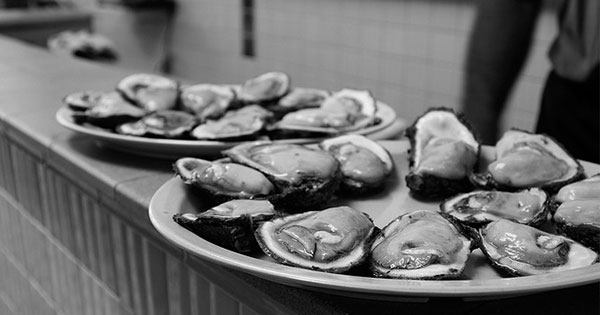
For the next several weeks, we will republish our favorite “Neutral Ground” columns from this year.
This Saturday afternoon at about three o’clock, the shucker at Casamento’s Restaurant on Magazine Street, near the corner of Napoleon Avenue, will shuck his last oyster for the season. Soon afterward the staff will close the Venetian blinds and pull down the steel shutter and button the place up until fall.
Casamento’s is famous for several things: first, the vast acreage of hygienic white tile on floor and walls, which founder Joe Casamento installed inside and out when he opened in 1919. (A fondness for tile evidently ran in the family; his brother’s restaurant on Freret Street, which had the same name, boasted in 1934 that, “The public is always welcome to visit Casamento’s tiled kitchen, one of the most sanitary and beautiful kitchens to be found in New Orleans.”) Casamento’s is also famous for its oysters, and thus for closing down in the summer, during the months without an “R.” (Yes, they’re open the month of May. No, you may not ask why.)
The “R” proscription originally took root around 1599, when British scribe Samuel Butler wrote, “It is unseasonable and unwholesome in all months that have not an R in their names to eat an oyster.” It’s true that bacteria is more abundant in coastal waters in warm weather. But eating oysters then is only marginally more risky. As Mark Kurlansky put it in his book The Big Oyster, “This is an ancient and somewhat mythological belief.”
Casamento’s ritual summer closing notwithstanding, New Orleans has long understood that oysters are desirable year-round. Nearly a century ago, the local newspaper remarked on “a noteworthy fact, and one often commented upon by visitors to New Orleans, [that] oysters are eaten in this city and state every day in the year. … There is never a day in which they are not eaten in abundance.”
Much of the reason for the abundant consumption is that oysters in New Orleans have always been cheap. Although you’re likely to pay $3.50 for a single Blue Point or Moonstone up north, served by a liveried attendant on a velvet pillow, Gulf oysters are usually about $12 per dozen, served right on a marble countertop by a guy named Thomas wearing a briny-slick apron.
Gulf oysters tend to be much larger than their temperate-latitude cousins thanks to warmer water and a longer growing season. I have seen visitors from the north rendered mute when presented with a tray of Gulf oysters. It takes considerable faith to let an oyster the size of a calf’s liver slide into your mouth. Once inside, it can seem that the oyster has become confused as to where to go next. (You may enter into a debate with local residents over the relative merits of Gulf vs. other oysters, but this is an inlet with no outlet, and I’d advise not going there.)
Owing to size, abundance, and price, Gulf oysters are more commodity than gemstone. Like petroleum, New Orleans oysters were once measured by the barrel—in 1919, nearly a million barrels of oysters were reported sold. In truth, this offers a glimpse of past culinary life in coastal cities everywhere, from Seattle to New York to London, with inexpensive oysters enjoyed by all classes at streetside stands.
In New Orleans, the democracy of the oyster happily persists. This is especially true at happy hour, when cheap oysters are available at bars and restaurants all around the city. Superior Seafood, a 10-minute walk from my house, offers them for 50 cents, and I can wash them down with half-price beer. Last week, I walked somewhat further down St. Charles Ave. to the Blind Pelican, where happy-hour oysters are 25 cents each. With a pint of cold beer, an afternoon snack of a dozen set me back just $8, or not much more than a Double Quarter Pounder Happy Meal.
Around 1900, a dozen oysters on the half shell could be had in New Orleans for between 10 and 15 cents—or about a penny apiece. (They were then about 50 cents a dozen in Texas.) If you offset for inflation, a penny in 1906 is worth approximately a quarter today.
So, sitting in a cool bar under live oaks in the late afternoon and eating oysters and drinking cold beer is to do more than just savor a lovely snack. It’s to accept a torch from long ago, and hold it just long enough to admire the flame before passing it on.

